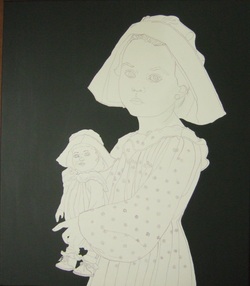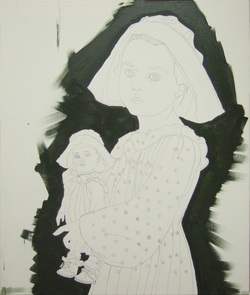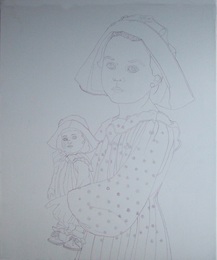
' China dolls ' stage 3
If the idea of a paint binder made from milk seems odd, consider where oil mediums come from, or using tree resins as varnishes, egg tempera, or glues from fish or animal hides. Most mediums and glues are organic in nature.
When used as a paint binder it is water soluble, and can be thinned to a wash much like watercolor, or applied in a thick paint layer approaching that of oils or acrylics.
It is about the most versatile medium there is, since it can be made into a size, a primer, and even combined with oil or acrylic paints. The true value of this medium for me was finding out how easily I could use it to make my own paints for underpainting just as the old masters practiced.

' China Dolls ' stage 2
What Is Casein paint ?
Casein is a protein found in milk. The name comes from the Latin word for cheese, "caseus," sometimes called "quark." Raw milk is made of mostly water, some fat, proteins and other solids. When an acid, such as vinegar, is added to milk it will separate into solids (curds) and liquids (whey.) Two cups of milk will yield about 1/4 cup of casein. Precipitating casein is the first step in making cheese; although, what is typically used for that is an enzyme called rennet. When an alkali is then combined with the casein it creates a strong adhesive. The alkali commonly used is hydrated lime or ammonium carbonate; however, those can cause the pH level to rise too high for artwork surfaces and some pigments. Borax is weak enough to not cause problems, and still make a very good casein binder.
' China Dolls ' project stage 1

'China Dolls' stage 1
' China Dolls ' I have photographed various stages of this project and will explain the methods used to achieve the finished painting. If anyone wishes me to expand further or a question arises, feel free to comment on the blog or use the contact tab. I will get back to you. There are often quicker or easier ways to approach painting & still get fairly similar end results but I enjoy my journey, rarely need to back track or lose my way. The techniques, application of paint and the hue should be sympathetic with the subject. I plan all that out just after the sketching stage. I start with a small manageable sketch, make my corrections and then sketch to the size of the intended finished work on cheap wall lining paper. I then decide on positioning & on this occasion moved the girl closer to the right of the canvas. Moving her up further and even more to the right so that her hat touched the upper right edge and top could have broke up the background with a more contemporary approach but may have veered too far from my attempts at conveying an old masters setting. Positioning her further down would give the illusion that the viewer is taller (adult), when in reality this is my little sister and the view is from my eyes, a little boy many years ago. The sketch is then transferred to canvas with very light use of graphite pencil, I then used a thin brush and painted the pencil marks in a dull but thin mauve which eventually vanishes with subsequent paint layers. More about this mauve colour and paint medium to follow.



 RSS Feed
RSS Feed